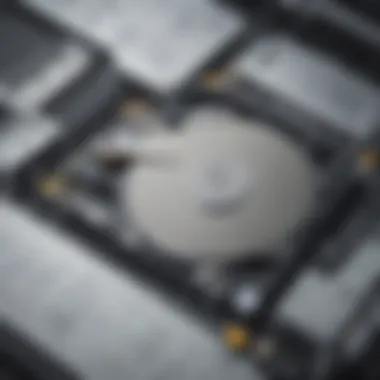Mastering Data Replication: A Comprehensive Guide to Cloning Your Hard Drive


Overview of Data Replication
Data replication, a crucial aspect of cybersecurity, involves the meticulous process of cloning a hard drive to ensure data integrity and security. Understanding the concept of hard drive cloning is fundamental before delving into the intricate methods and tools required for effective data duplication. With the increasing need for reliable backup and upgrade solutions, mastering the art of hard drive cloning is essential in safeguarding valuable information.
Methods and Techniques for Cloning
When initiating the process of cloning a hard drive, several methods and techniques can be employed to achieve successful data replication. Tools such as specialized software and hardware devices play a pivotal role in facilitating the cloning process, ensuring accurate duplication of data without compromising its quality. Exploring these methods in detail provides users with a comprehensive understanding of the intricate steps involved in cloning a hard drive.
Subsection: Disk Imaging
One common method used for hard drive cloning is disk imaging, which involves creating a complete copy or image of the original drive. This image, an identical representation of the source drive, is then transferred to a target drive, ensuring that all data, including the operating system and files, are replicated accurately. Disk imaging software simplifies this process, offering users a user-friendly interface to create and deploy drive images efficiently.
Subsection: File Transfer
Another approach to cloning a hard drive is through file transfer, which involves manually copying individual files from the source drive to the target drive. While this method may be more time-consuming and laborious, it provides users with greater control over the data selection and transfer process. By exploring both disk imaging and file transfer techniques, users can determine the most suitable method based on their specific requirements and technical proficiency.
Considerations for Data Replication
In addition to understanding the methods and tools for cloning a hard drive, various considerations must be taken into account to ensure a seamless replication process. Factors such as drive compatibility, storage capacity, and data encryption play a critical role in determining the effectiveness of the cloning procedure. By addressing these considerations proactively, users can mitigate risks and complexities associated with data replication, enhancing the overall reliability and security of the cloned data.
Conclusion
Introduction to Hard Drive Cloning
In the realm of digital storage, the concept of hard drive cloning emerges as a pivotal practice in safeguarding valuable data assets. This article delves deep into the nuances of hard drive cloning, shedding light on its significance in the realm of data replication. Through a meticulous exploration of this topic, readers are poised to grasp the intrinsic value of replicating data for purposes ranging from backup security to seamless hardware transitions and disaster recovery readiness.
Understanding the Need for Cloning
Importance of Data Backup
The cornerstone of ensuring data integrity lies in the robustness of data backup mechanisms. Embarking on the journey of hard drive cloning encompasses a strategic move towards bolstering data security and resilience. The essence of data backup embodies a proactive approach to mitigating risks of data loss due to unforeseen circumstances. Data backup serves as a linchpin in fortifying organizational and personal data repositories against the brunt of malicious cyber threats, hardware malfunctions, or inadvertent human errors.
Upgrading to a New Hard Drive


The process of migrating to a new hard drive heralds a phase of evolution and optimization for storage infrastructures. By embracing the practice of cloning, users can seamlessly transition to advanced storage solutions without compromising on data fidelity. Upgrading to a new hard drive through cloning not only streamlines the migration process but also ensures the seamless transfer of data configurations, applications, and settings. This bespoke approach to hardware enhancement minimizes downtime and operational disruptions, fostering a fluid evolution in technological ecosystems.
Disaster Recovery Preparedness
Anticipating and preparing for unforeseen data catastrophes forms the crux of disaster recovery preparedness. Through hard drive cloning, organizations and individuals can architect a robust disaster recovery framework that mitigates downtime and data unavailability. Disaster recovery preparedness, facilitated by hard drive cloning, empowers entities to swiftly recover and reinstate vital data assets in the aftermath of data breaches, system failures, or natural disasters. This proactive stance towards data resiliency epitomizes the prudence of preemptively safeguarding against existential data threats.
Benefits of Cloning
Time-Saving
Time-saving emerges as a premier virtue of hard drive cloning, expediting the data replication process without compromising on accuracy or completeness. The swiftness of cloning mechanisms minimizes operational disruptions, enabling users to efficiently duplicate large volumes of data within a fraction of the time traditionally consumed. This temporal efficacy positions hard drive cloning as a paramount strategy for optimizing productivity and operational efficiency in data-intensive environments.
Data Preservation
Preserving data integrity lies at the heart of hard drive cloning, ensuring that crucial data assets remain unscathed during replication processes. The fidelity of data preservation guaranteed by cloning techniques safeguards against data corruption or loss, thereby fortifying the long-term sustainability of digital archives. By conserving data integrity through meticulous cloning procedures, users instill trust in the resilience and longevity of their data repositories, underpinning the foundation of data-driven endeavors.
Flexibility in Hardware Changes
The adaptability and flexibility ushered in by hard drive cloning pave the way for seamless hardware transitions and upgrades. By cloning existing configurations onto new hardware setups, users can navigate hardware changes with unparalleled ease and efficiency. This flexibility extends beyond mere data replication, enabling users to tailor hardware configurations to meet evolving technological demands without compromising on data continuity. The agility afforded by hard drive cloning in accommodating hardware variations underscores its instrumental role in sculpting resilient and dynamic digital ecosystems.
Methods of Cloning
In the realm of hard drive replication, the methods of cloning play a pivotal role. Understanding the nuances of cloning methods is essential, as it lays the groundwork for successful data replication. When delving into the topic of Methods of Cloning, several key elements come into focus, including the intricate process of disk imaging and the use of hardware-based tools. These methods offer users the ability to duplicate data efficiently, ensuring the integrity and security of their information. The significance of exploring different cloning methods lies in the diverse benefits and considerations they bring to the table.
Software-Based Cloning
Disk Imaging Programs
Disk Imaging Programs are a crucial element of software-based cloning, offering users a comprehensive way to replicate their hard drives. These programs excel in creating exact copies of every bit of data on a drive, ensuring a precise duplication process. One key characteristic of Disk Imaging Programs is their ability to create a complete image of the source drive, including the operating system and all stored files. This feature proves beneficial for users looking to replicate their entire system seamlessly. However, the drawback lies in the time-consuming nature of creating large disk images, requiring ample storage space. Despite this, Disk Imaging Programs remain a popular choice for their ability to create reliable and exact copies of hard drives.
Built-in Operating System Tools
Built-in Operating System Tools offer a seamless and integrated approach to cloning, leveraging the existing functionalities of the operating system for data replication. These tools simplify the cloning process by providing a native solution within the operating system environment. A key characteristic of Built-in Operating System Tools is their user-friendly interface, making them accessible to a wide range of users without the need for additional software installations. While they may lack some advanced features present in third-party software, the convenience and ease of use make them a favorable choice for many. Their unique feature lies in their compatibility with the existing system, minimizing potential compatibility issues. However, their disadvantage may stem from limitations in customization and advanced cloning options.
Hardware-Based Cloning


Hardware-Based Cloning introduces a different approach to data replication, utilizing external devices and tools to duplicate hard drives effectively. External Docking Stations serve as a key aspect of hardware-based cloning, providing a versatile and convenient method for connecting drives externally. The key characteristic of External Docking Stations is their plug-and-play functionality, allowing users to easily insert drives for cloning without the need for extensive setup. This plug-and-play feature enhances user convenience and simplifies the cloning process, making it accessible even to those with limited technical expertise. However, the drawback of External Docking Stations may lie in their dependency on external hardware, which could potentially introduce additional points of failure.
Hard Drive Cloning Kits
Hard Drive Cloning Kits encompass a comprehensive solution for replicating data, offering users a complete set of tools and accessories for seamless cloning. These kits streamline the cloning process by providing all necessary components in a single package, ensuring users have everything they need to duplicate their hard drives effectively. The key characteristic of Hard Drive Cloning Kits is their inclusivity, offering users a one-stop solution for all their cloning requirements. This all-in-one feature simplifies the setup process and reduces the likelihood of missing essential tools for successful cloning. However, the potential disadvantage of Hard Drive Cloning Kits could be their cost, as they may be priced higher compared to individual tools. Despite this, the convenience and completeness they offer make them a preferred choice for users seeking a hassle-free cloning experience.
Considerations Before Cloning
In the realm of hard drive cloning, the preliminary step of Considerations Before Cloning holds utmost significance. Before embarking on the data replication journey, it is crucial to delve into aspects such as storage capacity and compatibility. This step ensures a seamless and successful cloning process, preventing potential complications and data loss. By paying meticulous attention to these considerations, users can safeguard their data and optimize their cloning experience.
Storage Capacity and Compatibility
Checking Disk Space Requirements
Checking Disk Space Requirements plays a pivotal role in the hard drive cloning process. By assessing the disk space needed for duplication, users can ensure that the target drive can accommodate all data without any data loss or incompatibility issues. It is essential to match the storage capacity of the source drive with that of the target drive to facilitate a smooth cloning operation. Checking Disk Space Requirements helps users determine the adequacy of space and prevents any issues arising from insufficient storage, guaranteeing a successful replication process.
Understanding File Systems
Understanding File Systems is another critical aspect that impacts the cloning procedure. Different file systems have varying structures and compatibilities, influencing how data is stored and accessed. By comprehending the intricacies of file systems, users can ensure that data is cloned accurately without any loss or corruption. Knowing the specific file system of the source drive and its compatibility with the target drive is vital to maintain data integrity throughout the cloning process. Understanding File Systems aids in preserving data structure and organization, essential for replicating data efficiently.
Data Security and Privacy
Encryption Measures
Encryption Measures introduce a layer of security to the cloning process, safeguarding sensitive data from unauthorized access or breaches. Encryption techniques encode data during transfer or storage, rendering it unreadable to unauthorized parties. By implementing encryption measures, users can protect confidential information during the cloning process, enhancing data security and privacy. The use of encryption ensures that cloned data remains secure and private, mitigating risks associated with data exposure or theft.
Secure Disposal of Old Drives
Secure Disposal of Old Drives is imperative for maintaining data privacy and security post-cloning. Proper disposal of old drives prevents data leakage and unauthorized access to sensitive information stored on the discarded drive. Secure disposal methods, such as data wiping or physical destruction, ensure that no traces of data remain on the old drive, minimizing the risk of data breaches. By securely disposing of old drives, users can mitigate the risk of data leaks and protect their privacy effectively.
Step-by-Step Cloning Process
In this detailed guide on hard drive cloning, the Step-by-Step Cloning Process section plays a crucial role in providing readers with a comprehensive understanding of the practical aspects involved in replicating data. It delves into the intricate details of how to successfully clone a hard drive, covering essential elements like preparation, execution, and post-cloning considerations. By focusing on a systematic approach to data replication, this section equips individuals with the necessary knowledge to safeguard their valuable information and facilitate seamless transitions between hardware devices.
Preparation Stage


Backing Up Data
Backing up data is a fundamental aspect of the preparation stage in hard drive cloning. It entails creating a duplicate copy of all files, ensuring that no valuable information is lost during the cloning process. The key characteristic of backing up data lies in its ability to serve as a failsafe mechanism, allowing users to restore their original files in case of any unforeseen issues. This proactive approach to data management proves to be a popular choice in this guide as it minimizes the risk of data loss and provides peace of mind to individuals seeking to safeguard their digital assets.
Selecting the Target Drive
Selecting the target drive is another pivotal task during the preparation stage of hard drive cloning. This involves choosing the destination drive where the cloned data will be transferred. The key characteristic of selecting the target drive is its role in determining where the replicated data will reside, thereby influencing the usability and accessibility of the cloned drive. By carefully considering factors such as storage capacity, compatibility, and future hardware requirements, users can make an informed decision that aligns with their specific needs and preferences. While this step offers the benefit of creating a replica of the original drive, users must also be mindful of potential disadvantages like compatibility issues or storage limitations.
Cloning Execution
Initiating the Cloning Software
Initiating the cloning software marks the beginning of the actual data replication process. This step involves launching the selected cloning tool or program to commence the cloning operation. The key characteristic of initiating the cloning software is its user-friendly interface and intuitive controls, making it a preferred choice for novice users embarking on their cloning journey. The unique feature of this process is its ability to create an exact copy of the source drive onto the target drive, ensuring data integrity and consistency throughout the cloning operation. While the advantages include simplicity and efficiency, potential disadvantages may arise from software limitations or compatibility issues with different drive types.
Verifying the Cloned Data
Verifying the cloned data is a critical aspect of ensuring the success of the cloning process. This step involves cross-checking the replicated data on the target drive to confirm its accuracy and completeness. The key characteristic of verifying the cloned data lies in its role in detecting any errors or discrepancies that may have occurred during the cloning operation. By meticulously comparing the original files with the cloned data, users can validate the integrity of the replicated information and address any potential issues promptly. While this verification step offers the advantage of data validation, users must remain vigilant against the possibility of overlooking subtle errors or inconsistencies that could impact the usability of the cloned drive.
Post-Cloning Considerations
Post-cloning considerations are an integral part of the hard drive cloning process, ensuring the stability and security of your replicated data. After successfully cloning your hard drive, it is crucial to validate and test the cloned drive to confirm its reliability and functionality. This phase acts as a quality control measure, verifying that the replication was accurate and error-free. By conducting comprehensive validation and testing procedures, you can mitigate the risk of data loss and system malfunctions, ultimately safeguarding your digital assets and optimizing performance.
Validation and Testing
Booting from the Cloned Drive
Booting from the cloned drive is a critical step in the validation process, as it verifies whether the replicated drive can function independently and seamlessly as the primary drive. By booting from the cloned drive, users can confirm that the operating system, applications, and data have been accurately copied and are operational. This step serves as a practical test of the cloning process, ensuring that all essential components are intact and functioning correctly. Booting from the cloned drive provides users with the confidence that their data replication was successful and that they can rely on the cloned drive for their computing needs.
Checking for Errors
Checking for errors post-cloning is essential to identify any discrepancies or corrupted data that may have occurred during the replication process. By meticulously scanning the cloned drive for errors, users can spot potential issues such as missing files, file corruption, or data integrity errors. This detailed error-checking process allows users to rectify any anomalies before they impact system performance or lead to data loss. By proactively detecting and addressing errors, users can ensure the reliability and integrity of their replicated data, enhancing the overall effectiveness of the cloning process.
Optimizing Performance
Defragmenting the Drive
Defragmenting the drive post-cloning is a recommended maintenance task that improves the efficiency and speed of data access on the newly replicated drive. Defragmentation rearranges fragmented data on the drive, reducing file access times and enhancing overall system performance. By defragmenting the cloned drive, users can optimize storage utilization and minimize wear and tear on the drive, prolonging its lifespan. This optimization process streamlines data retrieval and storage, ensuring that the replicated drive operates at peak performance levels.
Updating Drivers
Updating drivers on the cloned drive is essential to enhance hardware compatibility, resolve system conflicts, and address security vulnerabilities. By updating drivers to the latest versions, users can ensure that their hardware components are supported by the operating system and that any potential bugs or issues have been resolved. This proactive measure safeguards the cloned drive from compatibility issues and ensures a smooth and secure computing experience. Updating drivers enhances system stability, improves device performance, and protects against potential security threats, making this aspect crucial for optimizing the overall performance of the replicated drive.







